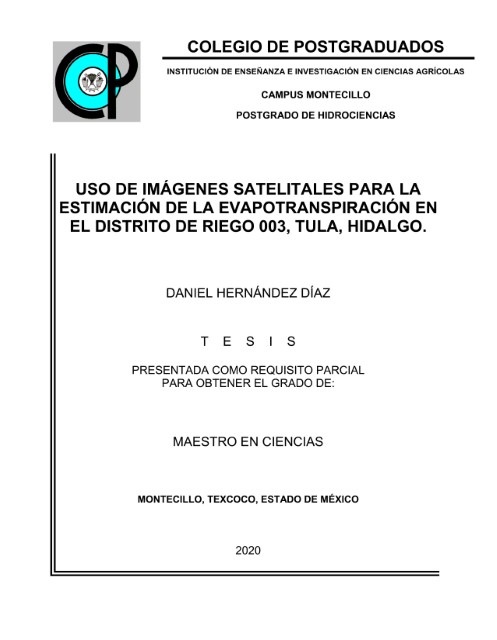
USO DE IMÁGENES SATELITALES PARA LA ESTIMACIÓN DE LA EVAPOTRANSPIRACIÓN EN EL DISTRITO DE RIEGO 003, TULA, HIDALGO.
Daniel Hernández Díaz, M.C. Colegio de Postgraduados, 2020
RESUMEN
El consumo de agua de los cultivos está dado por la
evapotranspiración (ET). Para determinar el valor de la ET existen
métodos directos e indirectos, los primeros tienen la desventaja de que
son costosos, requieren tiempo y personal calificado; los indirectos son
menos precisos, pero resultan más prácticos. La principal desventaja de
ambos métodos es que proporcionan la ET para una ubicación específica y
no proporcionan una estimación regional a un costo asequible. En los
últimos años, las técnicas de teledetección se han desarrollado
ampliamente debido a su capacidad para proporcionar datos periódicos y
estimaciones regionales confiables de ET. El balance de energía es una
de las técnicas más utilizadas, y uno de los modelos más estudiados es
el METRIC (Mapping Evapotranspiration at high Resolution and with
Internalized Calibration) desarrollado por la Universidad de Idaho.
METRIC es un modelo de procesamiento de imágenes para calcular la ET
como un residual del balance de energía en la superficie. El objetivo de
este trabajo fue estimar la evapotranspiración de los cultivos en el
Modulo de Riego Tepatepec del Distrito de Riego 003 Tula, Hidalgo,
utilizando el modelo METRIC, para lo cual, primero se validó el modelo
con datos medidos de ET en una torre de flujos. También, los resultados
de METRIC se compararon con la ET obtenida mediante la plataforma EEFlux
y la obtenida con la metodología del coeficiente de cultivo basal (kcb).
Se encontró una buena correlación al momento de validar METRIC con un
coeficiente de determinación (R2) de 0.925 y una raíz del cuadrado medio
del error (RMSE) de 0.517 mm día-1. También se acertó que la ET de la
plataforma EEFlux es la que presenta un mejor desempeño con respecto al
modelo METRIC.
Palabras clave: METRIC, EFFlux, coeficiente de cultivo basal, Landsat-8,
Eddy Covariance
USE OF SATELLITE IMAGES FOR THE ESTIMATION OF EVAPOTRANSPIRATION
IN THE IRRIGATION DISTRICT 003, TULA, HIDALGO.
Daniel Hernández Díaz, M.C.
Colegio de Postgraduados, 2020
ABSTRACT
The water consumption of the crops is given by evapotranspiration (ET). There are direct and indirect methods to determine the value of ET, the former have the disadvantage that they are expensive, require time and qualified personnel; indirect ones are less precise, but more practical. The main disadvantage of both methods is that they provide the ET for a specific location and do not provide a regional estimate at an affordable cost. In recent years, remote sensing techniques have been widely developed due to their ability to provide periodic data and reliable regional estimates of ET. The energy balance is one of the most used techniques and one of the most studied models is the METRIC (Mapping Evapotranspiration at high Resolution and with Internalized Calibration) developed by the University of Idaho. METRIC is an image processing model for calculating ET as a residual from the surface energy balance. The objective of this work was to estimate the evapotranspiration of the crops in the Tepatepec Irrigation Module of the Irrigation District 003 Tula, Hidalgo, using the METRIC model, for which the model was first validated with measured ET data in a tower of flows. Also, the METRIC results were compared with the ET obtained using the EEFlux platform and that obtained with the basal crop coefficient (kcb) methodology. A good correlation was found at the time of validating METRIC with a coefficient of determination (R 2 ) of 0.925 and a root of the mean square of the error . . (RMSE) of 0.517 mm day -1 . It was also found that the ET of the EEFlux platform is the one that presents a better performance with respect to the METRIC model.
Keywords: METRIC, EFFlux, basal crop coefficient, Landsat-8, Eddy Covariance.
Fecha: 2020-11
Estudiante: Daniel Hernández Díaz
MAESTRIA EN CIENCIAS - HIDROCIENCIAS
Consejo Particular:
Consejera: Dra. Antonia Macedo Cruz
Asesor: Dr. Ramón Arteaga Ramírez
Asesor: M.C. Guillermo Crespo Pichardo